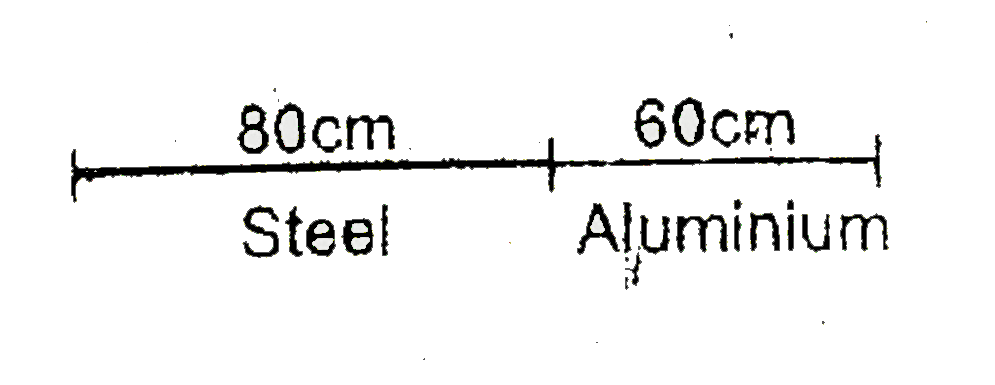Figure shows an aluminium wire of length 60cm joined to a steel wire of length 80cm and stretched between two fixed supports. The tension produced is 40N. The cross-sectional area of the steel wire is 1.0mm2 and that of the aluminimum wire is 3.0mm2 The minimum frequency of a tuning fork which can produce standing waves in the system with the joint as a node is 10P (in Hz) the find P. Given density of aluminimum is 2.6g/cm3 and that of steel is 7.8g/cm3.
 Solution in Tamil
Solution in Tamil
The correct Answer is:A
Ps=7.8gmcm3
PA=2.6gmcm3
ms=PsAs
=7.8×10−2gmcm
(m=mass per unit length)
7.8×10−3kgm
mA=PA
=21.6×10−2×3gmcm
=7.8×10−2gmcm
=7.8×10−3kgm
A node is always placed in the joint. Since aluminium and steel rod has same mass per unit lenght, velocity of wave in both of them is same
→v=√(Tm)
=
⎷{40(7.8×10−3)}
=√((4×104))7.8
=71.6ms
For minimum frequency there would be maximum wavelength. for maximu wavelength minimum no. of loops are to be produced.
∴ Maximum distance of a loop =20cm
→ wavelength =λ=2×20
=40cm=0.4m=180Hz
Topper's Solved these Questions
Similar Questions
A mechanical wave propagastes in a medium along the X-axis. The particles of the medium moves in what direction?
View SolutionThe gravitational force acting on a particle of 1 g due to a similar particle is equal to 6.67×10−17N. Calculate the separation between the particles.
06:48View SolutionThe mass of a cyclist together with the bicycle is 90 kg. Calculate the work done by cyclist if the speed increases from 6km/h to 12 km/h.
03:44View SolutionFigure shows an aluminium wire of length 60 cm joined to a steel wire of length 80 cm and stretched between two fixed supports. The tension produced is 40 N. The cross-sectional area of the steel wire is . 1.0 mm^2 and that of the aluminium wire is 3.0 mm 2. What could be the minimum frequency of a tuning fork which can produce standing waves in the system with the joint as a node ? The density of aluminium is 2.6 g cm^-3 and that of steel is 7.8gcm^-3
02:09View SolutionA steel wire of length 60 cm and area of cross section 10^(-6)m^(2) is joined with a n aluminimum wire of length 45 cm and are of cross section 3xx10^(-6)m^(2) . The composite string is stretched by a tension of 80 N. Density of steel is 7800kgm^(-3) and that of aluminimum is 2600kgm^(-3) the minimum frequency of tuning fork. Which can produce standing wave in it with node at joint is
04:26View SolutionA steel wire of length 50sqrt(3) cm is connected to an aluminium wire of length 60 cm and stretched between two fixed supports. The tension produced is 104 N , if the cross section area of each wire is 1mm^(2) . If a transverse wave is set up in the wire, find the lowest frequency for which standing waves with node at the joint are produced . (density of aluminimum = 2.6 gm//cm^(3) and density of steel = 7.8 gm//cm^(3) ).
04:26View SolutionA tuning fork produces 5 beats/sec with a senometer wire of length 78 cm. if the length of the wire is increased by 2 cm, then there is a resonance between the tuning form and the wire. The frequency of the fork is
03:06View SolutionA steel wire having cross-sectional area 2 mm^(2) is stretched by 20 N. Find the lateral strain produced in the wire Y_("steel") = 2 xx 10^(11) Nm^(-2), sigma = 0.391
03:26View SolutionA steel wire having cross-sectional area 2 mm^(2) is stretched by 20 N. Find the lateral strain produced in the wire
04:47View SolutionA tuning fork produces 5 beats s^(-1) with a sonometer wire of length 78 cm. If the length of the wire iscreased byy 2 cm, then there is a resonance between the tuning fork and the wire. The frequency of the fork is
07:09View SolutionA steel wire of length 2.5 m and area of cross section 1.25mm2, when it is stretched by a force of 40 N and Y for steel is 2×1011N/m2. The extension produced in a steel wire is
View SolutionA steel wire of length 5 m and area of cross-section 4mm2 is stretched by 2 mm by the application of a force. If young's modulus of steel is 2×1011N/m2, then the energy stored in the wire is
04:06View SolutionA metal wire of length 80 cm, area of cross-section 3 mm^(2) and material density 3000 kg m^(-3) is joined to another metal wire of length 60 cm, area of cross-sectional 1 mm^(2) and material density 9000 kg-m^(3) . The free ends of the two wires are stretched between two rigid supports and a tension of 40 N is produced in the wires. The minimum frequency of the tuning fork which can produce stationary waves with the joint of the wires as a node is
05:28View SolutionAn aluminium wire of length 60 cm and cross sectional area 10−2cm2 is joined with a steel wire of the same cross sectional area. A 10 kg mass is used to produce tension in the conjoined wires. The length of the steel wire is 86.8 cm . A transverse wave is produced in the wire with the help of an external source . Find the minimum frequency of vibration in the wire for which a stationary wave is produced with a node formed at the junction of the two wires. The densities of aluminium and steel are 2.6g⋅cm−3and7.8g⋅cm−3 , respectively .
06:38View SolutionThe tension produced in a sonometer wire is 60 N and the length between two bridges is 40 cm. The length of wire is 1 m and the mass of the wire is 2g. The speed of transverse waves produced in the wire is
View SolutionA steel wire of length 80 cm and of area of cross section 1.5 mm2 is stretched. Find the work done in increasing its length from 80.2 cm to 80.3 cm. (Y=2.0×1011Nm−2)
05:32View Solution

